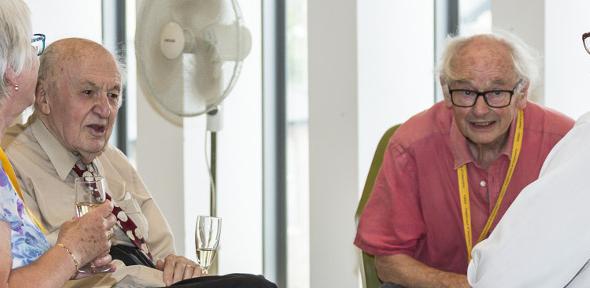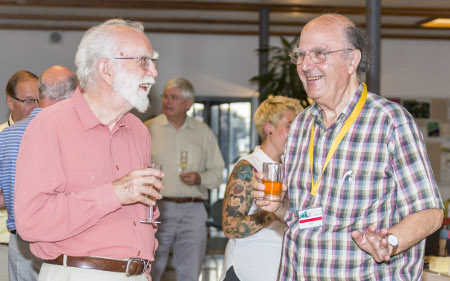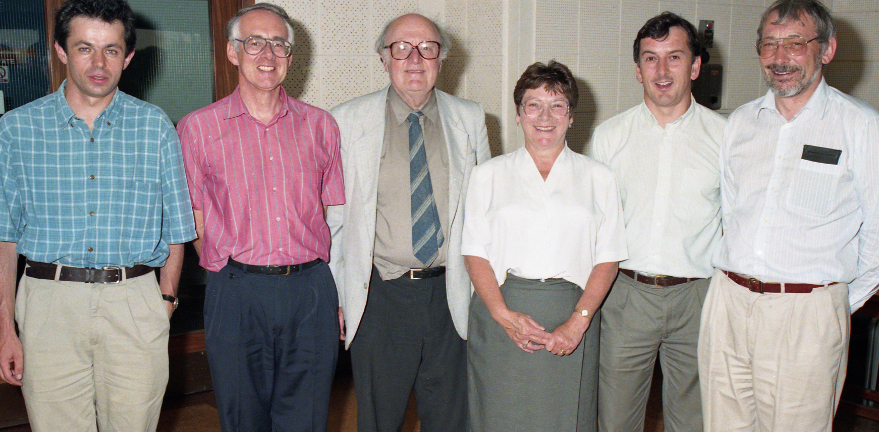
Colleagues and friends joined Brian Thrush on 27 July 2018 in the Cybercafé to help him celebrate his 90th birthday.
At the party, Head of Department Professor John Pyle touched on the highlights of Brian’s research career as well as his important involvement with the research councils. “With respect to my own field of atmospheric chemistry, this really was not a separate field at the time,” said John. “However, Brian’s research areas of kinetics and spectroscopy were central to the developing science, and as a Council member of NERC (the Natural Environment Research Council) Brian helped to set up New Blood lectureships in that area – he really helped to establish atmospheric science as a core field within the research councils.”

Brian came up to Emmanuel College in 1946, first as an undergraduate in Natural Sciences, and then as a PhD student in the Department of Physical Chemistry (as it was then). Brian started his research under Morris Sugden but John noted he was quickly “pinched” by Ronald Norrish because of his expertise in electronics. Brian helped Norrish and George Porter (later Lord Porter) develop their flash photolysis units for the study of extremely fast chemical reactions, work for which Norrish and Porter later won a Nobel Prize. [You can read more about their flash photolysis work in the Winter 2017 issue of Chem@Cam]. 
After a sabbatical in the US, Brian returned to the department, where he continued to investigate free radicals, chemiluminescence, kinetics and spectroscopy. Using the flash photolysis method, he made the first comprehensive examination of the absorption spectra of free radicals in homogeneous explosions. Amongst his many other research achievements, Brian developed a new method of studying hydrogen atom reactions, and determined the rate constants of a series of nitrogen, hydrogen and oxygen atom reactions important in combustion and in the upper atmosphere. Brian won the Tilden Prize of the Royal Society of Chemistry in 1965 and was elected a Fellow of the Royal Society in 1976, subsequently becoming a Professor here in 1978.

John recounted how Brian also played a key role in his own career: “I applied for one of the New Blood lectureships Brian helped to set up, and that’s how I came to Cambridge.” John recalled how he had made his first application to NERC for a studentship – in handwriting. (John has notoriously inscrutable handwriting). “Brian later told me that NERC had agreed to grant the studentship, but he did say next time I should get a typewriter!”
John also praised Brian for his role in bringing together the previously separate Chemistry Departments in the 1980s, as the first Head of a united Department of Chemistry. Many alumni will remember that although both departments moved to the Lensfield Road building in the late 1950s, they remained scrupulously segregated, with Ronald Norrish leading Physical Chemistry from the West side of the building and Alexander Todd presiding over Organic and Inorganic Chemistry on the East side.
Brian himself recounted that as early as the 1950s there had been a proposal to join the two departments, but the strong factions involved (along with the famously slow-turning wheels of university administration) meant that almost 30 years passed before this happened!
On a personal note, John recalled: “He and [his late wife] Rosemary were very welcoming to me when I came. He’s always been enormously kind and generous.” John noted that Brian was also acting master at Emmanuel College for a time and the Wine Steward for many years. “He is always good to go to for advice about wine!”
Many of Brian’s friends, former colleagues and students turned out to wish him well, including Adrian Tuck, Dame Mary Archer, Prudence Raphael and Pat Williams (the widows of former colleagues Ralph Raphael and Dudley Williams) and Allan Hayhurst (now Emeritus Professor in the Department of Chemical Engineering & Biotechnology). Emeritus Professors in the Department of Chemistry who attended included Jeremy Sanders, Brian Johnson, Tony Kirby, Ray Freeman, Tony Cox, Paul Davies, Sir Alan Fersht, Anthony Stone, Bill Jones, David Jefferson and Steven Ley.
Former student Richard Wayne (now Emeritus Professor of Chemistry at Oxford) said: “It was an excellent occasion that Brian is certain to recall with very happy memories, especially with so many visitors from outside Cambridge as well as from within. The turnout reflects the affection and esteem in which we hold Brian.”
 A slightly older photo of members of the (then) Department of Physical Chemistry from left: David Klenerman, Paul Davies, Brian Thrush, Anne Merry (head secretary), John Pyle and Tony Cox.
A slightly older photo of members of the (then) Department of Physical Chemistry from left: David Klenerman, Paul Davies, Brian Thrush, Anne Merry (head secretary), John Pyle and Tony Cox.

